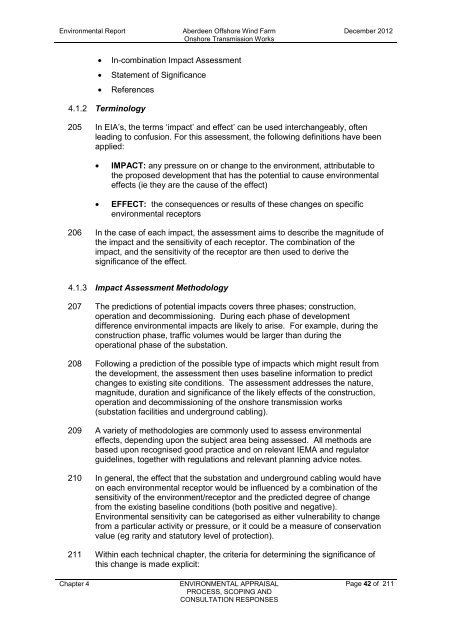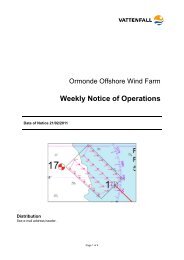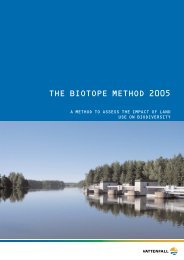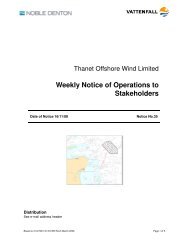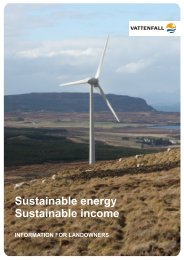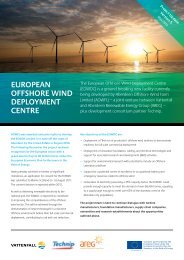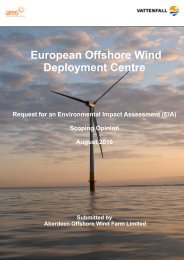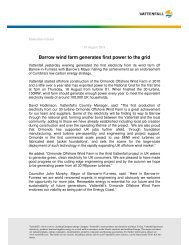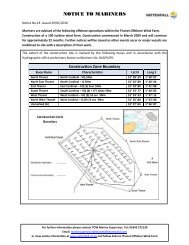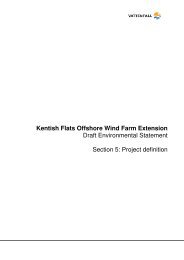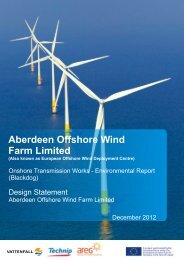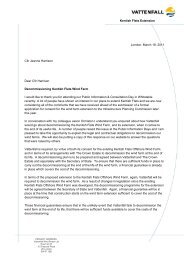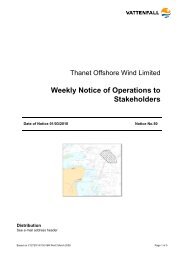Volume 2 Written Statement Full (PDF 4 MB) - Vattenfall
Volume 2 Written Statement Full (PDF 4 MB) - Vattenfall
Volume 2 Written Statement Full (PDF 4 MB) - Vattenfall
You also want an ePaper? Increase the reach of your titles
YUMPU automatically turns print PDFs into web optimized ePapers that Google loves.
Environmental Report<br />
Aberdeen Offshore Wind Farm<br />
Onshore Transmission Works<br />
December 2012<br />
• In-combination Impact Assessment<br />
• <strong>Statement</strong> of Significance<br />
• References<br />
4.1.2 Terminology<br />
205 In EIA’s, the terms ‘impact’ and effect’ can be used interchangeably, often<br />
leading to confusion. For this assessment, the following definitions have been<br />
applied:<br />
• IMPACT: any pressure on or change to the environment, attributable to<br />
the proposed development that has the potential to cause environmental<br />
effects (ie they are the cause of the effect)<br />
• EFFECT: the consequences or results of these changes on specific<br />
environmental receptors<br />
206 In the case of each impact, the assessment aims to describe the magnitude of<br />
the impact and the sensitivity of each receptor. The combination of the<br />
impact, and the sensitivity of the receptor are then used to derive the<br />
significance of the effect.<br />
4.1.3 Impact Assessment Methodology<br />
207 The predictions of potential impacts covers three phases; construction,<br />
operation and decommissioning. During each phase of development<br />
difference environmental impacts are likely to arise. For example, during the<br />
construction phase, traffic volumes would be larger than during the<br />
operational phase of the substation.<br />
208 Following a prediction of the possible type of impacts which might result from<br />
the development, the assessment then uses baseline information to predict<br />
changes to existing site conditions. The assessment addresses the nature,<br />
magnitude, duration and significance of the likely effects of the construction,<br />
operation and decommissioning of the onshore transmission works<br />
(substation facilities and underground cabling).<br />
209 A variety of methodologies are commonly used to assess environmental<br />
effects, depending upon the subject area being assessed. All methods are<br />
based upon recognised good practice and on relevant IEMA and regulator<br />
guidelines, together with regulations and relevant planning advice notes.<br />
210 In general, the effect that the substation and underground cabling would have<br />
on each environmental receptor would be influenced by a combination of the<br />
sensitivity of the environment/receptor and the predicted degree of change<br />
from the existing baseline conditions (both positive and negative).<br />
Environmental sensitivity can be categorised as either vulnerability to change<br />
from a particular activity or pressure, or it could be a measure of conservation<br />
value (eg rarity and statutory level of protection).<br />
211 Within each technical chapter, the criteria for determining the significance of<br />
this change is made explicit:<br />
Chapter 4<br />
ENVIRONMENTAL APPRAISAL<br />
PROCESS, SCOPING AND<br />
CONSULTATION RESPONSES<br />
Page 42 of 211


